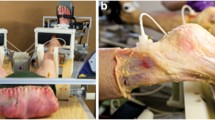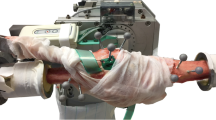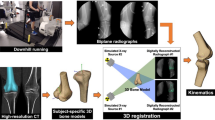Abstract
Purpose
Several studies have suggested that the iliotibial (IT) band plays a role in knee laxity and that it may affect the magnitude of the pivot shift observed. However, the extent of the role played by the IT band, as well as its mechanism of action, is not currently known. This cadaveric study aimed to quantify the effect of the IT band and the hip abduction angle on the magnitude of anterior tibial translation (ATT) during the pivot shift.
Methods
Six fresh-frozen hip-to-toes specimens were used. Serial sectioning of the anterior cruciate ligament (ACL) and the IT band was performed. Lachman and mechanized pivot shift manoeuvres were employed at each stage, and ATT of the lateral and medial compartments was measured using navigation. Three hip abduction angles were tested for each condition: 0°, 15° and 30°.
Results
Sequential sectioning of the ACL and the IT band resulted in a significant increase in ATT in both the lateral (Intact = 0 ± 0.5 mm; ACL deficient = 8.1 ± 0.2 mm; ACL + IT deficient = 10.8 ± 0.3 mm) and medial (Intact = 6.7 ± 0.4 mm; ACL deficient = 8.4 ± 0.3 mm; ACL + IT deficient = 9.9 ± 0.3 mm) compartments. No significant increase in ATT was observed after changing the hip abduction angle at each stage.
Conclusions
An increase in the magnitude of the pivot shift and the Lachman was observed as the constraint of the IT band was removed. Additionally, it was shown that the hip abduction angle at which the pivot shift test was performed did not significantly affect the magnitude of ATT in this cadaveric model.

Similar content being viewed by others
References
Ahlden M, Araujo P, Hoshino Y, Samuelsson K, Middleton KK, Nagamune K, Karlsson J, Musahl V (2012) Clinical grading of the pivot shift test correlates best with tibial acceleration. Knee Surg Sports Traumatol Arthrosc 20(4):708–712
Araujo PH, Ahlden M, Hoshino Y, Muller B, Moloney G, Fu FH, Musahl V (2012) Comparison of three non-invasive quantitative measurement systems for the pivot shift test. Knee Surg Sports Traumatol Arthrosc 20(4):692–697
Bach BR Jr, Warren RF, Wickiewicz TL (1988) The pivot shift phenomenon: results and description of a modified clinical test for anterior cruciate ligament insufficiency. Am J Sports Med 16(6):571–576
Bedi A, Musahl V, Lane C, Citak M, Warren RF, Pearle AD (2010) Lateral compartment translation predicts the grade of pivot shift: a cadaveric and clinical analysis. Knee Surg Sports Traumatol Arthrosc 18(9):1269–1276
Benjaminse A, Gokeler A, van der Schans CP (2006) Clinical diagnosis of an anterior cruciate ligament rupture: a meta-analysis. J Orthop Sports Phys Ther 36(5):267–288
Brophy RH, Voos JE, Shannon FJ, Granchi CC, Wickiewicz TL, Warren RF, Pearle AD (2008) Changes in the length of virtual anterior cruciate ligament fibers during stability testing: a comparison of conventional single-bundle reconstruction and native anterior cruciate ligament. Am J Sports Med 36(11):2196–2203
Bull AM, Earnshaw PH, Smith A, Katchburian MV, Hassan AN, Amis AA (2002) Intraoperative measurement of knee kinematics in reconstruction of the anterior cruciate ligament. J Bone Joint Surg Br 84(7):1075–1081
Bull AMJ, Amis AA (1998) The pivot-shift phenomenon: a clinical and biomechanical perspective. Knee 5(3):141–158
Citak M, Suero EM, Rozell JC, Bosscher MR, Kuestermeyer J, Pearle AD (2010) A mechanized and standardized pivot shifter: technical description and first evaluation. Knee Surg Sports Traumatol Arthrosc 19(5):707–711
Colombet P (2011) Knee laxity control in revision anterior cruciate ligament reconstruction versus anterior cruciate ligament reconstruction and lateral tenodesis: clinical assessment using computer-assisted navigation. Am J Sports Med 39(6):1248–1254
Colombet P, Robinson J, Christel P, Franceschi J-P, Djian P (2007) Using navigation to measure rotation kinematics during ACL reconstruction. Clin Orthop Relat Res 454:59–65
Fetto JF, Marshall JL (1979) Injury to the anterior cruciate ligament producing the pivot-shift sign. J Bone Joint Surg Am 61(5):710–714
Galway HR, MacIntosh DL (1980) The lateral pivot shift: a symptom and sign of anterior cruciate ligament insufficiency. Clin Orthop Relat Res 147:45–50
Galway RD, Beaupré A, MacIntosh DL (1972) Pivot shift: a clinical sign of symptomatic anterior cruciate insufficiency. J Bone Joint Surg Br 54-B(4):763–764
Grood ES, Suntay WJ (1983) A joint coordinate system for the clinical description of three-dimensional motions: application to the knee. J Biomech Eng 105(2):136–144
Hoshino Y, Araujo P, Ahlden M, Moore CG, Kuroda R, Zaffagnini S, Karlsson J, Fu FH, Musahl V (2012) Standardized pivot shift test improves measurement accuracy. Knee Surg Sports Traumatol Arthrosc 20(4):732–736
Katz JW, Fingeroth RJ (1986) The diagnostic accuracy of ruptures of the anterior cruciate ligament comparing the Lachman test, the anterior drawer sign, and the pivot shift test in acute and chronic knee injuries. Am J Sports Med 14(1):88–91
Lane CG, Warren R, Pearle AD (2008) The pivot shift. J Am Acad Orthop Surg 16(12):679–688
Lane CG, Warren RF, Stanford FC, Kendoff D, Pearle AD (2008) In vivo analysis of the pivot shift phenomenon during computer navigated ACL reconstruction. Knee Surg Sports Traumatol Arthrosc 16(5):487–492
Losee RE (1983) Concepts of the pivot shift. Clin Orthop Relat Res 172:45–51
Markolf KL, Jackson SR, McAllister DR (2010) Relationship between the pivot shift and Lachman tests: a cadaver study. J Bone Joint Surg Am 92(11):2067–2075
Matsumoto H (1990) Mechanism of the pivot shift. J Bone Joint Surg Br 72(5):816–821
Merican AM, Amis AA (2009) Iliotibial band tension affects patellofemoral and tibiofemoral kinematics. J Biomech 42(10):1539–1546
Monaco E, Maestri B, Labianca L, Speranza A, Kelly MJ, D’Arrigo C, Ferretti A (2010) Navigated knee kinematics after tear of the ACL and its secondary restraints: preliminary results. Orthopedics 33(10 Suppl):87–93
Musahl V, Citak M, O’Loughlin PF, Choi D, Bedi A, Pearle AD (2010) The effect of medial versus lateral meniscectomy on the stability of the anterior cruciate ligament-deficient knee. Am J Sports Med 38(8):1591–1597
Musahl V, Hoshino Y, Ahlden M, Araujo P, Irrgang JJ, Zaffagnini S, Karlsson J, Fu FH (2012) The pivot shift: a global user guide. Knee Surg Sports Traumatol Arthrosc 20(4):724–731
Musahl V, Voos J, O’Loughlin PF, Stueber V, Kendoff D, Pearle AD (2010) Mechanized pivot shift test achieves greater accuracy than manual pivot shift test. Knee Surg Sports Traumatol Arthrosc 18(9):1208–1213
Noyes FR, Grood ES (1987) Classification of ligament injuries: why an anterolateral laxity or anteromedial laxity is not a diagnostic entity. Instr Course Lect 36:185–200
Robinson J, Carrat L, Granchi C, Colombet P (2007) Influence of anterior cruciate ligament bundles on knee kinematics: clinical assessment using computer-assisted navigation. Am J Sports Med 35(12):2006–2013
Suero EM, Citak M, Choi D, Bosscher MR, Citak M, Pearle AD, Plaskos C (2011) Software for compartmental translation analysis and virtual three-dimensional visualization of the pivot shift phenomenon. Comput Aided Surg 16(6):298–303
Terry GC, Norwood LA, Hughston JC, Caldwell KM (1993) How iliotibial tract injuries of the knee combine with acute anterior cruciate ligament tears to influence abnormal anterior tibial displacement. Am J Sports Med 21(1):55–60
Yamamoto Y, Hsu WH, Fisk JA, Van Scyoc AH, Miura K, Woo SL (2006) Effect of the iliotibial band on knee biomechanics during a simulated pivot shift test. J Orthop Res 24(5):967–973
Author information
Authors and Affiliations
Corresponding author
Rights and permissions
About this article
Cite this article
Suero, E.M., Njoku, I.U., Voigt, M.R. et al. The role of the iliotibial band during the pivot shift test. Knee Surg Sports Traumatol Arthrosc 21, 2096–2100 (2013). https://doi.org/10.1007/s00167-012-2257-2
Received:
Accepted:
Published:
Issue Date:
DOI: https://doi.org/10.1007/s00167-012-2257-2




